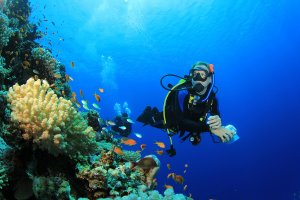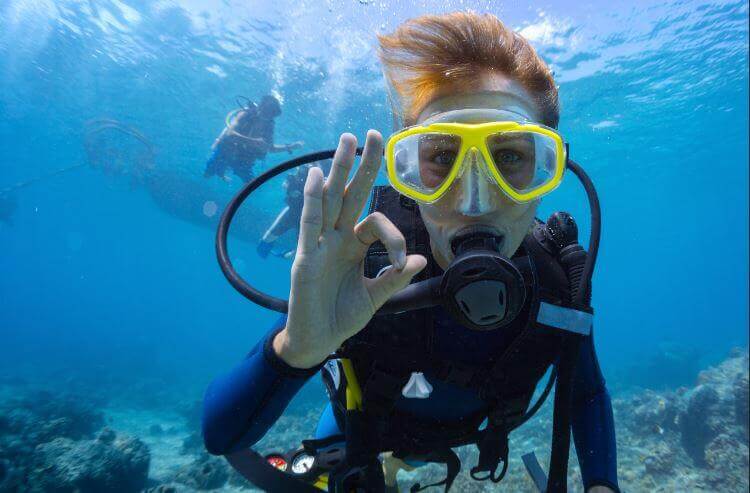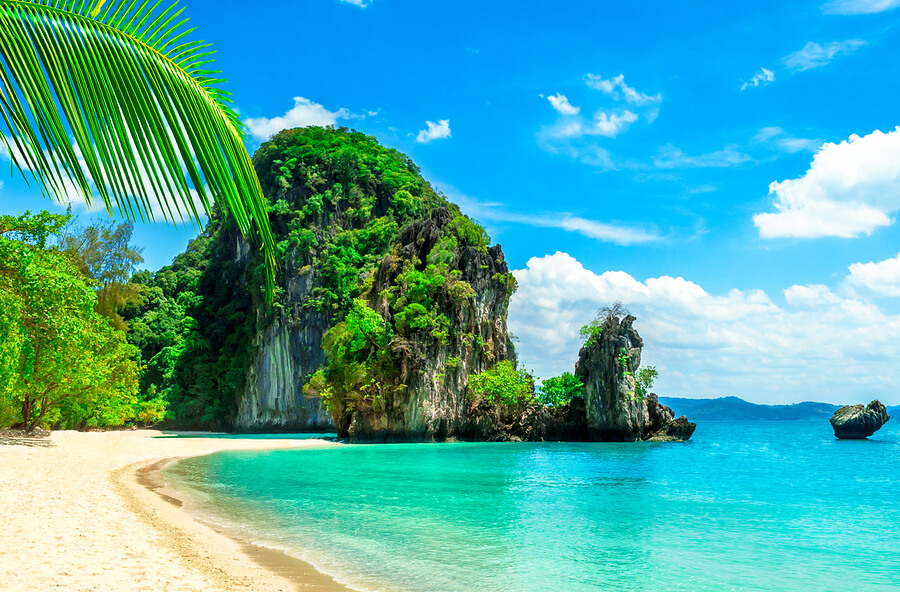The 7 Top Places to Scuba Dive

Are you looking for something different this summer? How about a new adventure? Dive into the depths of the ocean! In our post today, read about the best spots to scuba dive. Make sure you have your suit ready!
Where are the best places to scuba dive?
If you want to save your next vacation from monotony and repetitions from vacations-past, we have just the solution: scuba diving! But not sure where to go? No problem! Read about the best places to scuba dive in the world with us today:
1. Cocos Island (Costa Rica)
The best months to visit this paradise is between January and April, and between September and October. After diving in its beautiful waters– which have an average temperature of 80º F– you’ll find hammerheads and whale sharks, rays, turtles, dolphins, tuna, octopuses and many more in their natural habitats.
You can’t miss out on scuba spots: Dirty Rock, Shark Fin Rock and Bajo Alcyone. You can only access the island through a cruise as it’s too far off-coast for a day-trip.
2. Ningaloo Reef (Australia): Let’s scuba dive!
Australia is famous for its beautiful coral reefs. Don’t skip the 1,600-mile-long Great Barrier Reef, which makes a sublime scuba destination. Here, you can run into whale sharks– the biggest species of fish in the world.
And if you visit during the sea turtle mating season, you can see turtles laying eggs right on the beach of the Indian Ocean. As if that wasn’t enough, you can also enjoy the incredible signs during your entire adventure.

3. Scuba dive in Raja Ampat (Indonesia)
This treasure is located in the West Papua province in Indonesia. According to scuba experts, it’s the number one destination for scuba diving. Why? You can find no less than 75 percent of all the coral species in the world here.
It’s a marine oasis that boasts more than 1,000 animal species, including sea turtles, manta rays, fish, seahorses, crabs, and sharks. The best time to visit Raja Ampat is between October and April. Don’t miss out on Farondi, The Passage, Fabiact, Cape Kri, Boo Rock, and Manta Ridge.
4. Ras Muhammad (Egypt): Perfect for a scuba dive
What about scuba diving in the Red Sea? The crystal clear sea is one of the best places to scuba dive. Enjoy the sight of colorful corals and fish. You can also find shipwrecks, such as the Thistlegorm Cargo Ship, which sank back in 1941.
The Ras Muhammad National Park oversees the Gulf of Suez and Aqaba. it is located seven miles from the touristic city Sharm el-Sheikh.
5. Komodo National Park (Indonesia)
Not only is this island famous for one of the very few places where you can see Komodo dragons in their natural habitat, but it’s also a scuba paradise. This UNESCO World Heritage site offers plenty of opportunities to see indigenous plants and animals.
6. Maldives
The Maldives may be a classic luxury honeymoon destination but they’re also one of the best places to scuba dive because you can dive all year round. However, the best time to visit is between January and April.
In the waters of the Maldives– which have an average temperature of 80º F– prepare to find manta rays, barracudas, pufferfish, dolphins, whales and hammerhead sharks, lionfish, moray eels and more. Must-see spots are Hanifaru Bay, Manta Point, Hammerhead Point, Maaya Thila, and Kuderah Thila.

7. Galapagos Islands
Located in the Pacific Ocean, the Galapagos Islands aren’t only home to turtles but also to a large variety of marine species, including hammerhead sharks.
Wolf and Darwin Islands are diving favorites thanks to the lower amounts of tourism and impressive natural scenery. The best time to visit is between July and November.
Want to know more spots? Banco de la Plata (Dominican Republic), Solomon Islands, Palau (Micronesia), Sipadan (Malaysia), Roatán (Honduras), Baja California (Mexico), Easter Island (Chile), Great Blue Hole (Belize), Gran Cenote (Mexico) and the Cayman Islands.
Are you looking for something different this summer? How about a new adventure? Dive into the depths of the ocean! In our post today, read about the best spots to scuba dive. Make sure you have your suit ready!
Where are the best places to scuba dive?
If you want to save your next vacation from monotony and repetitions from vacations-past, we have just the solution: scuba diving! But not sure where to go? No problem! Read about the best places to scuba dive in the world with us today:
1. Cocos Island (Costa Rica)
The best months to visit this paradise is between January and April, and between September and October. After diving in its beautiful waters– which have an average temperature of 80º F– you’ll find hammerheads and whale sharks, rays, turtles, dolphins, tuna, octopuses and many more in their natural habitats.
You can’t miss out on scuba spots: Dirty Rock, Shark Fin Rock and Bajo Alcyone. You can only access the island through a cruise as it’s too far off-coast for a day-trip.
2. Ningaloo Reef (Australia): Let’s scuba dive!
Australia is famous for its beautiful coral reefs. Don’t skip the 1,600-mile-long Great Barrier Reef, which makes a sublime scuba destination. Here, you can run into whale sharks– the biggest species of fish in the world.
And if you visit during the sea turtle mating season, you can see turtles laying eggs right on the beach of the Indian Ocean. As if that wasn’t enough, you can also enjoy the incredible signs during your entire adventure.

3. Scuba dive in Raja Ampat (Indonesia)
This treasure is located in the West Papua province in Indonesia. According to scuba experts, it’s the number one destination for scuba diving. Why? You can find no less than 75 percent of all the coral species in the world here.
It’s a marine oasis that boasts more than 1,000 animal species, including sea turtles, manta rays, fish, seahorses, crabs, and sharks. The best time to visit Raja Ampat is between October and April. Don’t miss out on Farondi, The Passage, Fabiact, Cape Kri, Boo Rock, and Manta Ridge.
4. Ras Muhammad (Egypt): Perfect for a scuba dive
What about scuba diving in the Red Sea? The crystal clear sea is one of the best places to scuba dive. Enjoy the sight of colorful corals and fish. You can also find shipwrecks, such as the Thistlegorm Cargo Ship, which sank back in 1941.
The Ras Muhammad National Park oversees the Gulf of Suez and Aqaba. it is located seven miles from the touristic city Sharm el-Sheikh.
5. Komodo National Park (Indonesia)
Not only is this island famous for one of the very few places where you can see Komodo dragons in their natural habitat, but it’s also a scuba paradise. This UNESCO World Heritage site offers plenty of opportunities to see indigenous plants and animals.
6. Maldives
The Maldives may be a classic luxury honeymoon destination but they’re also one of the best places to scuba dive because you can dive all year round. However, the best time to visit is between January and April.
In the waters of the Maldives– which have an average temperature of 80º F– prepare to find manta rays, barracudas, pufferfish, dolphins, whales and hammerhead sharks, lionfish, moray eels and more. Must-see spots are Hanifaru Bay, Manta Point, Hammerhead Point, Maaya Thila, and Kuderah Thila.

7. Galapagos Islands
Located in the Pacific Ocean, the Galapagos Islands aren’t only home to turtles but also to a large variety of marine species, including hammerhead sharks.
Wolf and Darwin Islands are diving favorites thanks to the lower amounts of tourism and impressive natural scenery. The best time to visit is between July and November.
Want to know more spots? Banco de la Plata (Dominican Republic), Solomon Islands, Palau (Micronesia), Sipadan (Malaysia), Roatán (Honduras), Baja California (Mexico), Easter Island (Chile), Great Blue Hole (Belize), Gran Cenote (Mexico) and the Cayman Islands.
All cited sources were thoroughly reviewed by our team to ensure their quality, reliability, currency, and validity. The bibliography of this article was considered reliable and of academic or scientific accuracy.
- Romero, L. Disfruta de cinco días de buceo y cuidado marino. 24 Horas. Octubre de 2019 https://www.24-horas.mx/2019/10/25/disfruta-de-cinco-dias-de-buceo-y-cuidado-marino/
- Monzón, P. Cozumel celebrará su festival de buceo Scubafest. Periodista digital. Octubre de 2019. https://www.periodistadigital.com/magazine/viajes/20191024/cozumel-celebrara-festival-buceo-scubafest-noticia-689404170263/
This text is provided for informational purposes only and does not replace consultation with a professional. If in doubt, consult your specialist.








